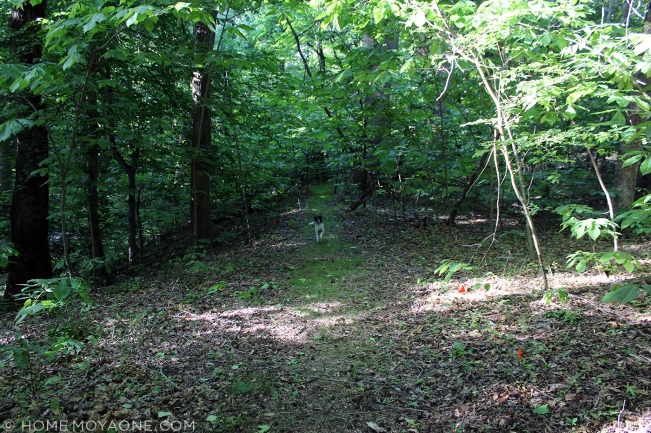
I hope you all enjoyed your 4th of July weekends. We went to a community picnic on the 3rd and, on the 4th, climbed a nearby hill to watch foggy, drizzly, fireworks from towns across the Potomac River. We also had a 4th of July surprise, which you’ll see at the end of this post. In the meantime, I’d like to share with you a project we’ve been working on for a couple summers now: our trail!

(Beware, vicious patrol puppy.) I mentioned this project in February 2015, when we were just getting started. Now we have a complete loop, with a couple of shortcuts even.
I used a free phone app to estimate the trail’s distance (just shy of half a mile!), then took a screen shot, overlaid that on our site plan from 1976, and voilá!—this really slick trail map. It’s suspect, however, since I walked the path twice and got different squiggly lines each time, but it gives you the gist of how traily our trail is.

There’s a small natural clearing at a bend in the trail that overlooks a drop-off. We don’t have neighbors to the east, so we have a nice view of a wooded valley. A future project we have in mind is to spruce this up into a camp site for us…or for obnoxious house guests.
Let’s take a walk!
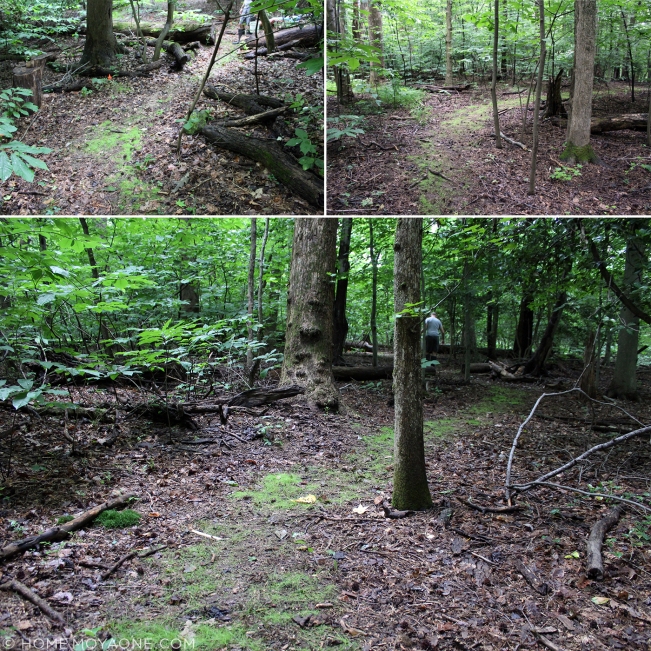
The paw paws are putting out fruit. They’ll be ready to eat when they start falling from the trees, in about two months. I get a kick out of the fruits hanging overhead—though I don’t much care for them now maybe someday I will acquire a taste. And there’s always paw paw wine to be made.
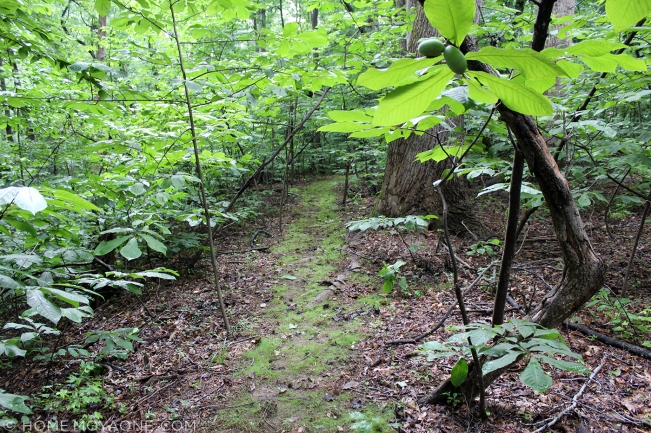
The trail winds under trees…
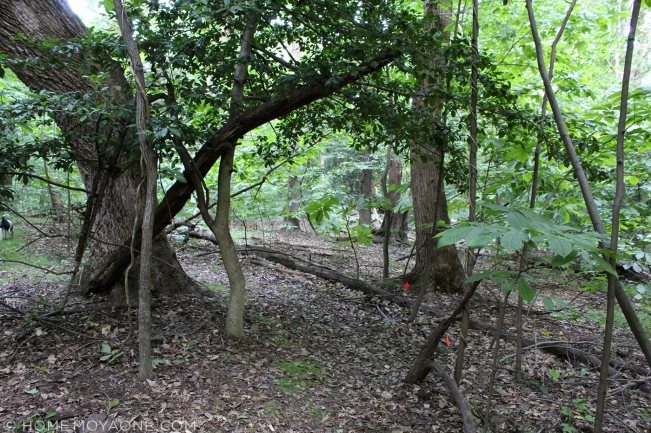
…and past some odd twisty trunks, and natural steps…

…and buttress roots…

…and in one of my favorite parts of the trail, alongside these big old tulip poplars.
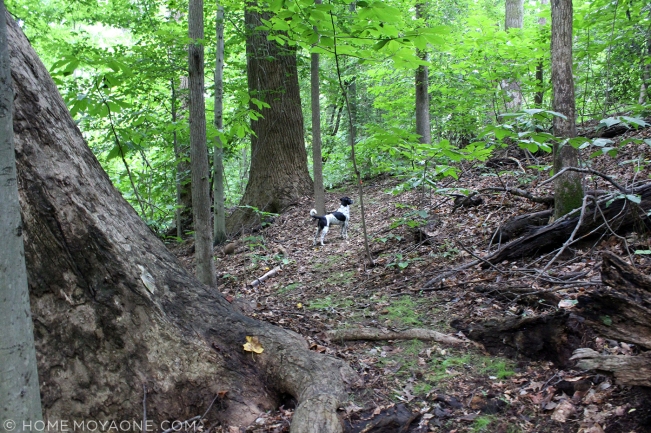

For a sense of scale, here’s a picture from a couple years ago (Jamie models late spring blaze-and-puffer-vest fashion; the trail now runs along the left side of the tree):

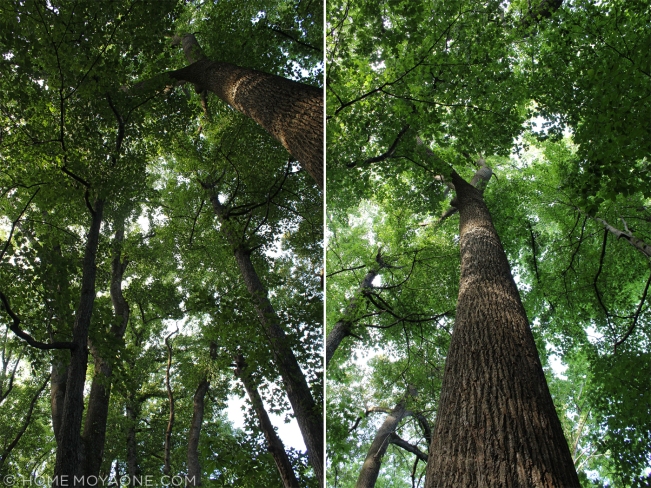
To make the trail, we first used flag markers (the kind you’d use to mark underground utilities) to roughly lay out a path. We wanted to create something gently meandering with interesting things to see along the way. We’d walk around a lot, back-and-forth, look at the possibilities from different angles, and decide, okay we need to see this tree along the way, and let’s pass under this, and let’s go over here. Sometimes that meant re-directing the portion of trail we’d just made to create a nicer meander or to hit the landmarks. When we felt good about our rough trail, we cleared brush, pulled small trees like the scrub paw paw (with the Extractigator—highly recommended), pruned low branches, and sometimes, cut through downed trees. In one we made a rudimentary bench:
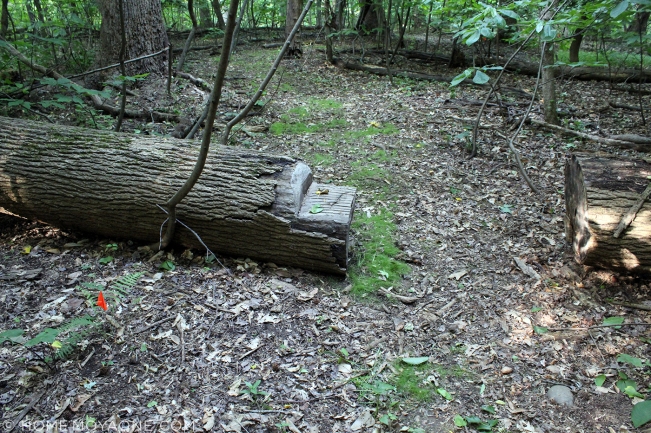
And where the trail loops back and passes again through that same tree, we cut through the whole mess of upper branches. It’s a neat effect to walk through.

We are still refining the trail, and—especially after it has rained—we occasionally have to clear fallen branches. We’ve basically made up our trail technique as we’ve gone along, so if you know of any good resources for trail creation and maintenance, please let us know in the comments!

When I previously wrote about the trail, we had planted a ground cover that was too tasty for the turkeys and deer. Now we’re trying to make grass work, specifically creeping red fescue. Creeping red fescue is native to Maryland and one of the best grasses for shade. It’s drought tolerant, and doesn’t require mowing—if you like that mop top look, which we do.
So we’re broadcasting grass seed out in the woods, like a couple of lost Demeters. Between rains (ideally) we’ll sprinkle seed on any exposed ground. Fall and spring are supposedly the best times for seeding grass, but we’re still spreading seed in July under the assumption that the moist shade maintains the spring-like germination conditions. Right now our grass path is spotty, but the fescue should eventually spread by rhizomes. And possibly we’ll switch to wood chips in areas that are too dark or covered in too much leaf litter for the grass to take.
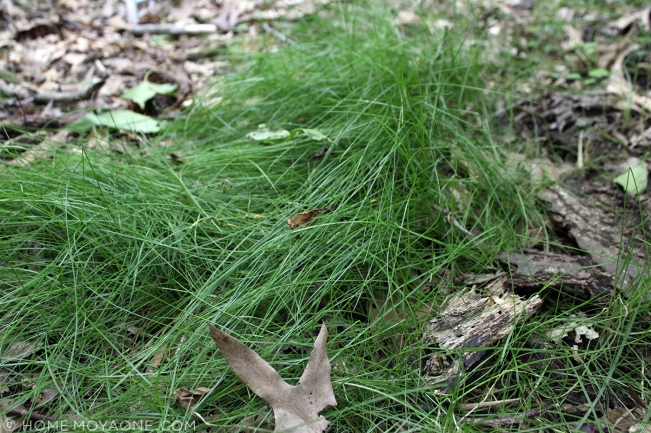

In February a bunch of neighbors in the Reserve banded together for an order of native plants from Mid Atlantic Native Plants. (Teaming up is a great way to get the quantity discount on plants.) Jamie ordered some more trees for the living fence he’s been working on, and I ordered 150+ bare root ferns.
I planted 100 of the ferns along the path, and nearly all of them have survived and are putting out fronds. (woot!) I planted Sensitive Fern (above), Marginal Wood Fern, Northern Lady Fern, and New York Fern. (The other 50 ferns are Hay Scented Ferns, which I planted in the front of the house with the hope that they’d form a colony where not much else is currently growing. Hay Scented Fern is pretty aggressive so hopefully it keeps that asshole stiltgrass at bay.)
I marked the planting spots with flags, since the bare root plants were just rootstocks or pieces of rhizome that blend in with the ground. You might have noticed orange flags in the trail photos—there lives a fern I planted. I plan to keep the flags in through the winter, to see which ferns make it through to the spring.

We still have work to do. We’re planning to build steps down this slope (above), using a stack of black locust which was gathered from dead trees on our property. The logs will make the risers, and we’ll secure them with rebar and pack earth between for the treads.

So there you have it, our trail. Or path. Whatever you want to call it. It’s our pride and joy.
In other exciting (and related) news, we have finally had some mushroom success. Jamie has been refining and adjusting his technique but to date there has been no mushroom ragu, no mushroom pizza, no mushroom soup…but just the other day the bioluminescent mushrooms made an appearance.
A bit more than a year ago Jamie inoculated a couple of beech logs with luminescent panellus mushrooms (Panellus stipticus) and ghost fungus (Omphalotus nidiformis). We think that this was in April or May 2015, but we’re not certain because this was before we kept a house journal of projects. He planted the logs next to the path like sign posts. The log with the ghost fungus doesn’t seem to be taking, but…
On the 4th of July, we spotted the panellus log covered with mushrooms. ‘merica!


And they really do glow in the dark. It’s really, really neat. We went out last night and took some photos using a tripod, slow shutter speed, and high ISO.
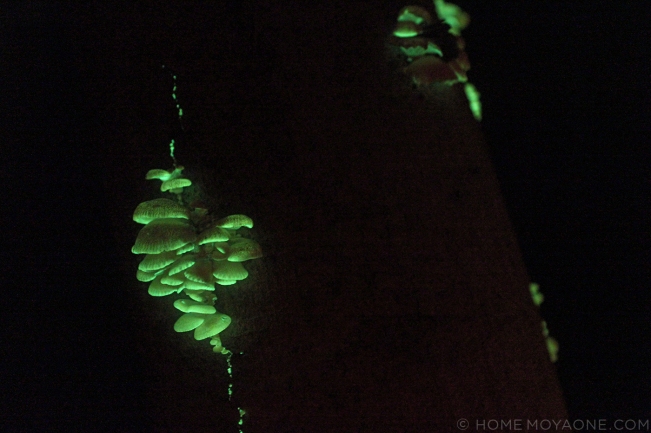
Below is a side-by-side comparison (I didn’t move the tripod between photos) of the bioluminescent mushrooms in the dark, and the exact same mushrooms with a light shining on them:

Can’t eat ’em, but finally—some mushroom success!

One Response to Trail-blazing, and mushroom-growing
Fantastic!